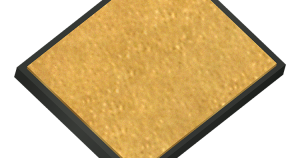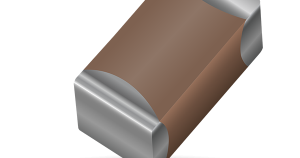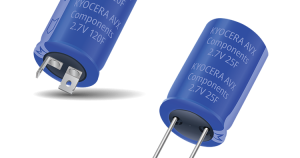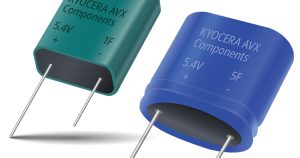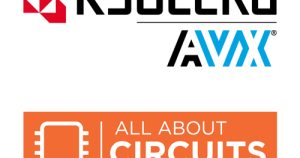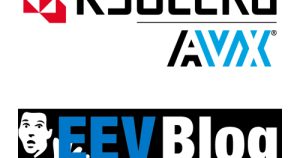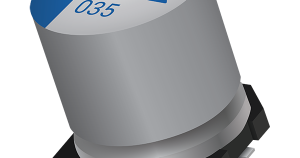Board space limitations are pushing for smaller components and greater component density while maintaining or improving broadband performance. The industry has tried to accommodate board limitations by embedding components within the board material itself. Even though many passive components are designed to have a minimal part height, traditional capacitors are thicker components, which makes them undesirable for embedded solutions. This study focuses on the Metal Oxide Silicon (MOS) Capacitor technology, and how these capacitors are ideal for embeddable applications, and help improve high-frequency performance. EverythingRF September 2024
Media Coverage
Johnson’s approximation is implemented in a finite element code to simulate the electric field dependence of a core–shell microstructure material. We show how the microstructure, based here on a 50:50 volume fraction, influences the measured effective permittivity as a function of applied voltage. Using a Johnson’s parameter of β = 1.0 × 1010 Vm5/C3, verified from commercial BaTiO3-based multilayer ceramic capacitors (MLCC), we show how the microstructure and the difference in core and shell conductivities alter the local fields generated and how this influences the voltage dependence of the effective permittivity. Systems that comprise a conductive core-like material surrounded by a resistive shell experience little or modest voltage dependence due to the shell material providing shielding to large electric fields
Several individual electronic trends have come together to create low-cost, easy-to implement energy management circuits capable of total power supply control of scavenged and harvested energy supplied to small loads. These circuits can significantly extend the life of a battery powering the load or entirely replace the battery. Among the trends propelling practical, low-cost scavenged energy modules are: the development of ultra-low power (ULP) ICs the ability to create efficient ultra-low-power dc-dc converters with control logic, allowing intelligent energy measurement and management functions the introduction of high-capacitance storage devices in miniature sizes. This article builds upon a previous work discussing the benefits of ULP IC technology. Here, we will discuss the performance and characteristics of a scavenging/harvesting circuit in powering
Decades ago, perhaps one of the first practical lessons a circuit designer would learn at the outset of their career was the art of decoupling using a combination of different value capacitors. A good mentor would explain that because of their physical characteristics, different value capacitors were optimal for filtering different frequency bands. This author even remembers designing a decoupling network for a 25W buck converter that included the parallel combination of ceramic capacitors of 1 μF, 0.1 μF, 0.01 μF, and 1000 pF in value. The network performed well once the component leads were made short enough! blog.Mini-Circuits.com July 31, 2023
What has been a catalyst in the development of the indigenous LED ecosystem? From Make in India, Street Lighting National Programme (SLNP) to Unnati Jyoti by Affordable LEDs for All (UJALA) scheme all these government policies are known to have set the Indian LED industry to a new benchmark. But lack of skilled manpower, high capital investment, lack of infrastructure, and dependence on imports are the heat that the LED Industry in India has been facing. To understand the critical aspects, the viability of Government initiatives and how truly India can become a hub for electronic systems design and manufacturing, TIMES TECH BUZZ in its cover story brings the eloquent discourse of… TechTimes.in June 2023
MIL-PRF-32535 for discrete MLCCs has led to the discussion of stacked ceramic capacitors based on BME technology. Stacked ceramic capacitors are multiple discrete multi-layer ceramic capacitors (MLCCs) terminated onto a common lead-frame for through-hole or SMT operations. They capture many of the inherent benefits of MLCC technology, like a low-loss material set, low ESR (equivalent series resistance), and higher reliability. Typical applications like switch mode power supplies need larger capacitance values and current capabilities. Stacked MLCCs compete with discrete electrolytic capacitor technology in terms of capacitance range but have an advantage in terms of voltage and temperature capability, which naturally increases their reliability, thereby making this a preferred technology for defense applications despite its higher price point compared to electrolytics.
A growing number of applications, ranging from solar power converters all the way to miniature power supplies for highly complex processing cores, are starting to capitalize on the benefits of aluminum electrolytic capacitors. Aluminum electrolytics are also increasingly used to satisfy miniaturization demands in complex power tree applications like FPGAs powered by multiple voltages. And while it’s true that aluminum electrolytics also come with disadvantages, several of the more well-known ones are no longer true, and other perceived disadvantages can be reduced or eliminated by selecting newer components engineered to overcome some of the technology’s traditional shortcomings. Power Systems Design (PSD) December 22nd 2022
There are many places you could implement energy-harvesting (EH) sensors in factory automation and measurement applications. For example, remote or hard-to-access applications that currently rely on physical equipment inspections for status updates could be converted to a wireless sensor network, provided that there is enough energy nearby to capture and that the measurements are sufficient for making an informed decision. Control Design October 6th 2022
Advanced tantalum capacitors and supercapacitors are enabling advanced ICs to be powered by compact and low-cost energy harvesting and scavenging sources. These developments make possible maintenance-free control systems in IoT applications extending from remote monitoring to smart industrial point controllers, wearable electronics, and location tracking devices. Power Electronic Tips (An EE World Online Resource) EE World | Power & Energy Efficiency Handbook 2022 September 29th 2022
Dale Wilson chats with Ron Demcko of KYOCERA AVX about their Miniature & High Capacitance MLCC. All About Circuits August 9, 2022
You might think you know how film capacitors fail and degrade in capacitance over time – self-healing due to surges, right? WRONG! Capacitor expert and AVX Fellow Ron Demcko confirms what’s really going on after a teardown of some failed and one good polypropylene X class capacitor. EEVBlog July 21, 2022
As e-mobility continues to expand, the automotive industry is presented with many design challenges, like fitting more robust electric motors, controls, and modules into a vehicle while maintaining reliability and signal integrity and reducing weight—where possible—to extend battery life and driving range. designing-electronics.com (DENA) May / June 2022
Capacitors are among the most widely used passive components in electronics, so naturally they find their way into many applications in harsh operating environments. In certain applications such as those in oil logging, jet aircraft, nuclear power generation, and other industrial applications, these components are subject to extremely high temperatures, often somewhere in the range of 180°C to 300°C. how2power.com March 2022
The need for bulk capacitors is growing due to a combination of increased production levels of traditional electronics, circuit trends requiring high capacitance values on supply rails, distributed energy/energy harvesting trends and new electronic circuitry replacing non-electronic applications. The most visible examples of these are low-voltage ICs and electronics integrated into items as simple as everyday hand tools (cordless tools, electronic levels, etc.) to Wi-Fi-linked rain gauges, general-purpose IoT modules and more. Electronic proliferation is across all industry sectors and applications. how2power.com February 2022
Decades of research and development dedicated to GaN RF power semiconductor technology has led to an increasing supply of affordable RF power devices with impressive performance. GaN semiconductors have reduced material capacitance and enhanced electron mobility, resulting in… microwavejournal.com October 2021
Today’s LED lighting and industrial electronics applications can achieve greater efficiency, performance, and reliability by employing connectors with high power densities and small form factors. Which connector characteristics best support these goals? This specification guide can help you decide. ConnectorSupplier.com October 2021
